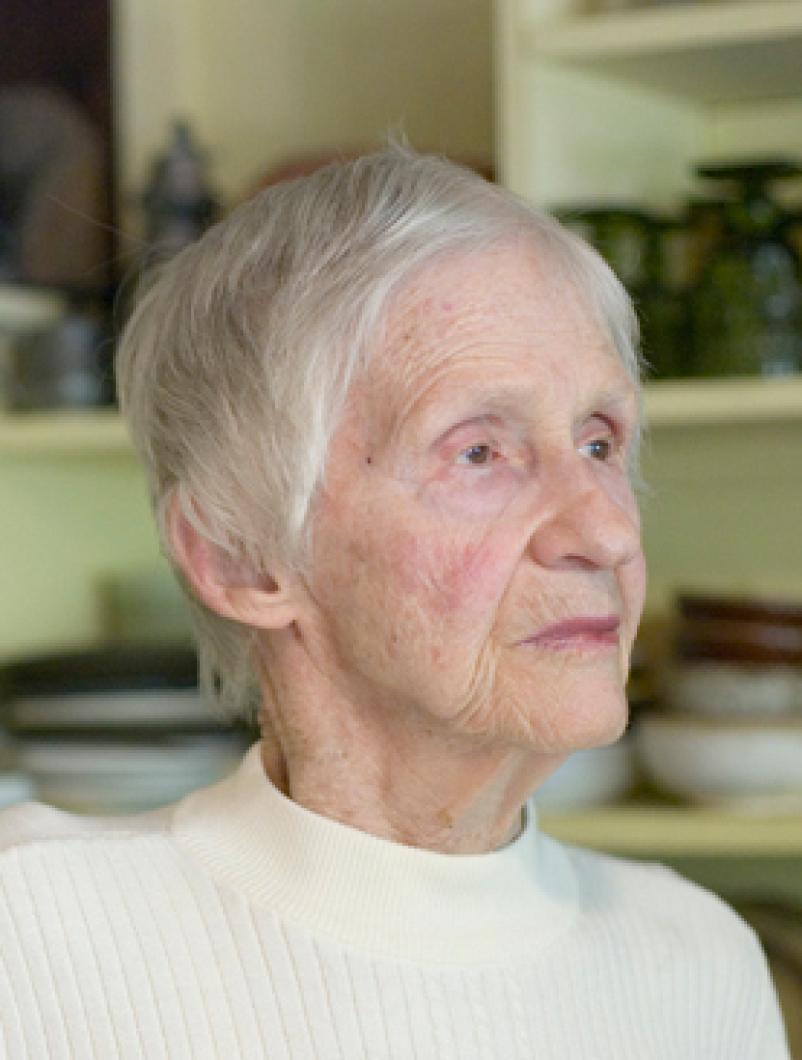It is what you read when you don’t have to that determines what you will be when you can’t help it. So said the Irish playwright Oscar Wilde.
The bookshelves in the West Tisbury kitchen of writer, gardener and gastronome Jean Stewart Wexler are floor to ceiling. And on every shelf are cookbooks — splattered with grease, dog-eared and colored the yellow-brown of books well-read. In a nook beside her stove, within reach in case there is a question mid-sauté, are the staples: Jane Brody’s Good Food Book, the New York Times Cookbook and an old edition of the Joy of Cooking.
Mrs. Wexler has done many things in her life — copy edited for Random House, had articles published in the New York Times and wrote the garden column in this newspaper for 17 years — but her cookbooks prove that at heart, she is a cook.
“I eat well every night,” said Mrs. Wexler, whose other claim to fame is author of the Martha’s Vineyard Cookbook, released in its fourth edition this month. “I never just have any old thing.”
Raised in North Carolina and Kentucky by parents who loved to garden, Mrs. Wexler cooks with what she grows or catches. “I don’t buy local, everything is so bloody expensive,” she said. So, peas and tomatoes from the backyard go into soups. In her younger days — she bemoans her health, which keeps her from her garden and the water — she caught fish in the afternoons and grilled it for dinner that night.
It was after one such meal, served outside on a summer evening many years ago, that Mrs. Wexler first entertained the idea of writing a cookbook featuring local food and local recipes.
“I had a friend who was an editor at Knopf,” Mrs. Wexler said from her living room recently. “We were sitting out on the back porch and she said, ‘Why don’t you write a Martha’s Vineyard cookbook, Jean?’ And I began to think about it because I am a good cook, I know a lot of recipes, I love food.”
At Random House, Mrs. Wexler copy edited many cookbooks. She loved to cook for dinner guests, to eat and to write, but she did not have the professional experience of a chef. So she teamed up with her friend and neighbor Louise Tate King, a Cordon Bleu-trained chef who was something of an Island culinary institution. Mrs. King was responsible for bringing the first French restaurant to the Island. “Everyone who came to the Vineyard went to Louise Tate King’s,” Mrs. Wexler said. Today the Edgartown site on upper Main street houses Atria restaurant.
The two met years earlier through a one-act play Mrs. King directed with Mrs. Wexler acting in it. Later, Mrs. Wexler worked at Mrs. King’s restaurant. Their partnership was a practical one. “Louise was outgoing, I am not,” said Mrs. Wexler of her colleague, who passed away in 2000. “I like to be where I can’t see anybody or hear anybody, which is kind of antisocial, I guess,” she said.
To prepare for the book, Mrs. King took to the kitchen to craft and perfect 250 recipes while Mrs. Wexler turned to the history of Martha’s Vineyard. She dug through newspaper archives, town annual reports and library reference books. “I thought it was interesting and relevant and people would like it,” she said of the lengthy introductions which begin each chapter, the stories behind old-fashioned recipes like Sea Voyage Gingerbread, and the instructions on how to properly prepare everything from littlenecks to venison. “I wanted it to be more than a cookbook.”
In 1971, Harper and Row published the cookbook. A review in this newspaper had this to say of the writers: “[They] appear to value modesty over display and tasteful honesty over even the most delicious gastronomic deception.” The book, which back then cost $8.95, was reprinted seven times.
In 1993, the small New England imprint Globe Pequot called the duo and asked if they would be game to write a second edition. They went through the original, corrected some mistakes (“We had the clams for clams casino baking for an hour,” Mrs. Wexler proclaimed. “My God! They’d just be little burned up hunks by that time!”) and eliminated 30 recipes to make room for 30 new ones. A third edition came out in 2000, the year of Mrs. King’s death, with the help of friend Linda McGuire.
Two years ago, Mrs. Wexler’s editor wrote her to ask if she would do a fourth. She declined. The following year, he wrote again. This time, Mrs. Wexler mentioned it to Mrs. McGuire who said she would be crazy not to accept. Mrs. McGuire offered her assistance, as did Mrs. King’s daughter, Hilary King Flye.
Like the previous editions, the fourth has exchanged 30 old recipes for 30 new. Favorite chapters — an entire one devoted to chowder, another to blueberries and cranberries alone — are still there and new ones have been added: Portuguese and Brazilian Cookery, African-American Cookery.
And like the previous editions, this latest iteration of the book remains much more than a collection of recipes. It is a cultural and culinary history of the people and things which are uniquely Martha’s Vineyard. Recipes for chowders from corn to quahog come from the files of Henry Beetle Hough, former editor of the Vineyard Gazette, and Will Holtham of the Menemsha Home Port. Captain Everett Poole’s fish recipe is there, as is one for Allen Farm stuffed leg of lamb. A chapter on Moors and Meadows features beach plums, rose hips and beach peas.
In the forward for the second edition, New York Times food columnist Florence Fabricant wrote: “Island settlements must of necessity be self-sustaining.” With her passion for the local as a driving force, Mrs. Wexler has proved that this book can sustain itself through the passing of a collaborator, four editions and even rubbery clams casino.





Comments
Comment policy »